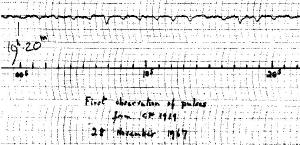Post
Little Green Men
14 May 2013
 Jocelyn Bell
Jocelyn BellIn 1967 a PhD student named Jocelyn Bell detected a radio signal with an odd regularity. Patterns can be heard in all sorts of radio signals, but this particular signal was unusual in that it was a pulse with a period of 1.33 seconds. You can see this pattern in the figure below (http://goo.gl/I4NMJ), and you can hear what the signal sounds like here.
Together with her advisor Antony Hewish, they found that the signal came from the same location in the sky, and followed sidereal time, which meant it was not caused by some terrestrial source. They half jokingly referred to the signal as LGM-1, where LGM stood for “Little Green Men.” The signal was so incredibly regular that the idea that the signal was produced by an alien intelligence crossed their minds.
Soon other similar signals were discovered, and it was clear that they were due to a natural process. By 1968 it was determined that these signals were produced by rotating neutron stars.
Neutron stars have intense magnetic fields. As a charged particles are trapped near the magnetic poles, they give off intense beams of radio waves. The rotation of the neutron star (and thus the poles) sweeps the beam around, much like the light from a lighthouse. When the beam is facing us, we see a pulse, and the rate of that pulse is the rate at which the neutron star spins.
These objects are now known as pulsars, and their discovery led to Hewish (but not Bell) being awarded the Nobel prize in physics in 1974.